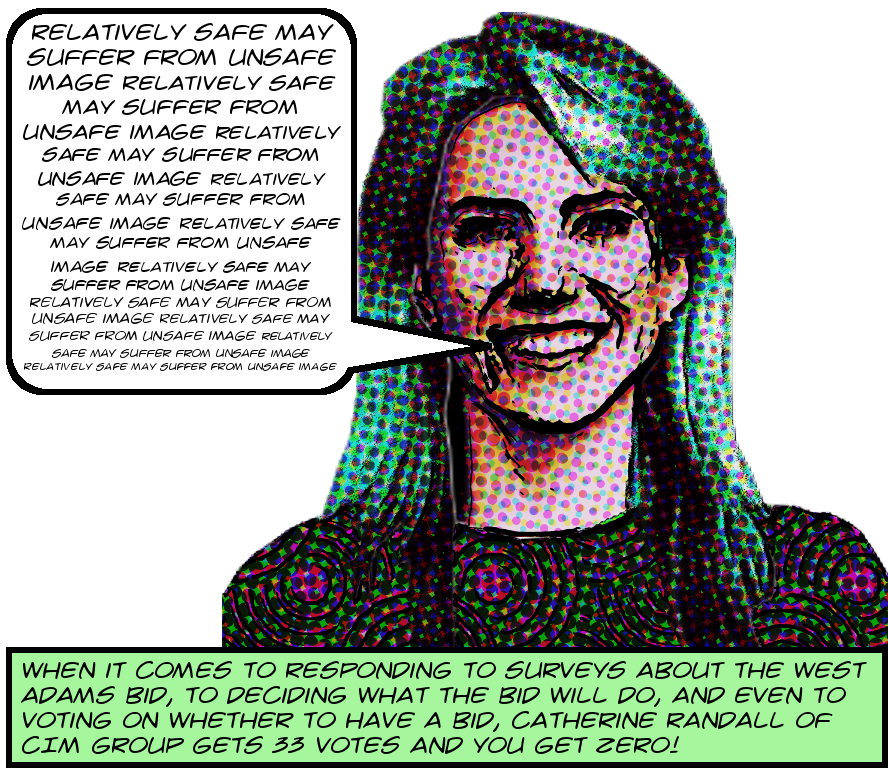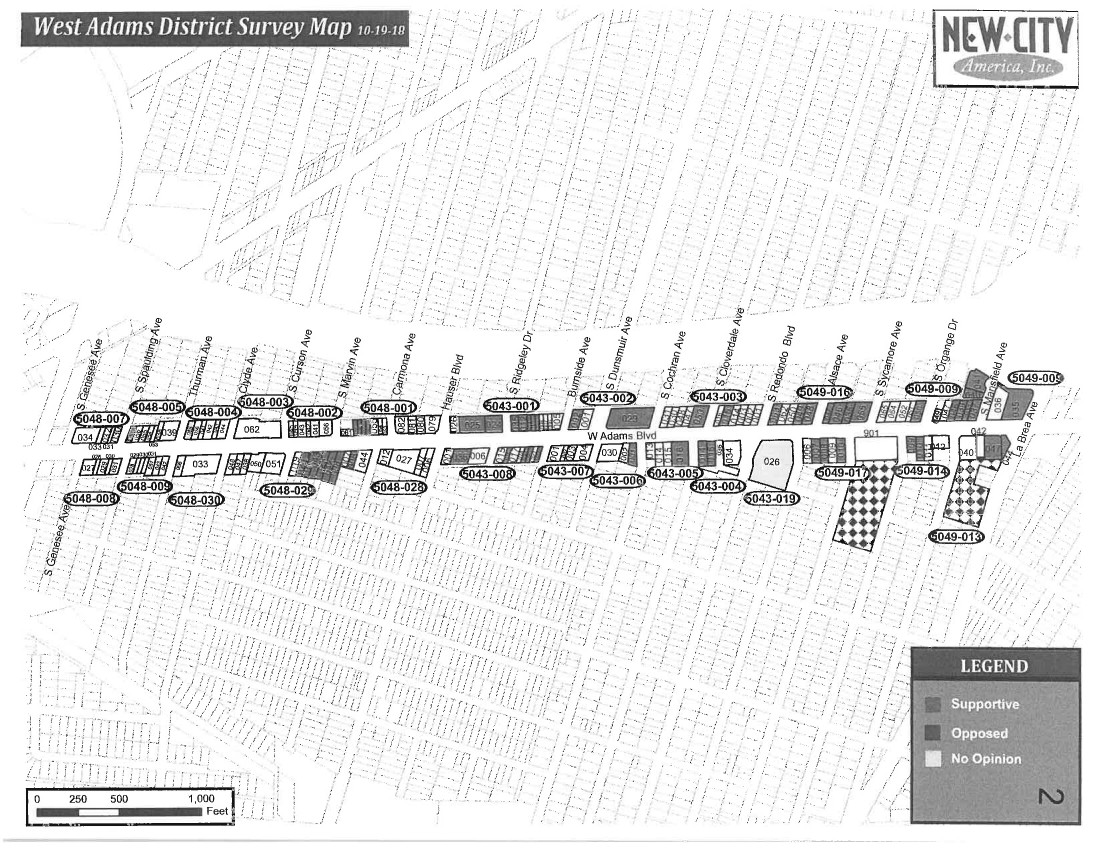 It was just revealed a few weeks ago that New City America, a BID consultancy helmed by noted legal scholar1 and raging psychopath Marco Li Mandri, has been planning a business improvement district for West Adams in concert with co-conspirators CIM Group. And yesterday I finally managed to lay my hands on a little more specific information. This all comes from this 11 page packet, handed out at the most recent meeting of the proposed BID’s steering committee.
It was just revealed a few weeks ago that New City America, a BID consultancy helmed by noted legal scholar1 and raging psychopath Marco Li Mandri, has been planning a business improvement district for West Adams in concert with co-conspirators CIM Group. And yesterday I finally managed to lay my hands on a little more specific information. This all comes from this 11 page packet, handed out at the most recent meeting of the proposed BID’s steering committee.

Of the most immediate import is this map of the proposed district. For the first time we know that, at least at the end of October 2018 it was planned to run along West Adams from La Brea to Genesee. There’s also this summary showing that, again as of October 2018, the property owners were polling at 39% in favor of BID establishment. Don’t forget, though, that per the Property and Business Improvement District Act at §36621(a) they’re not counting individual property owners, but weighting them by assessments to be paid.2 This document is also essential because it exposes a long list of hitherto unknown LLCs that CIM uses to own its various properties.
If that sounds high, well, it’s not surprising. See this list of parcels in the proposed BID sorted by whether the owners are in favor or not. See that Catherine Randall, who is VP in charge of some damn crapola at CIM group, is the designated representative for a full 33 parcels. Sadly, without more information than I’ve been able to gather, I’m not able to determine what percent of the voting power this will give CIM group. But it’s going to be high. They’re the largest single owner in the proposed district.3 The only thing we can be sure of is that they hold less than 39% of the total square footage.
And the last important bit of documentation to be found here is this copy of a questionnaire that Marco Li Mandri sent out to the property owners. This one has a tally of the responses to the various questions, which is also interesting. The City of LA requires this kind of polling before they’ll get behind a BID establishment process, but you can see from this instance that there is no kind of quality control at all. Just for freaking instance, the very first question asks “In terms of security and public safety, do you feel that West Adams District is…? (a) safe and orderly (b) Relatively safe, may suffer from unsafe image (c) Unsafe
This, friends, is a highly problematic question. Most of the the things that are wrong with business improvement districts are somehow reflected in this question. It is … well, turn the page for some discussion…
When people start talking about whether or not a neighborhood is safe, it’s essential to figure out who it’s supposed to be safe for. It’s possible to use the LA Times crime mapping project as a proxy for an objective measure, and on that score, West Adams (which encompasses more than the BID area does) is number 28, significantly safer than e.g. either Hollywood or Fairfax. Both of those neighborhoods, though, have a much better reputation for safety among CIM Group’s target market. This is because they’re not basing their perception so much on crime statistics.
Clearly the kind of people that CIM group hopes to attract to its megamultiplexical-use-structures are not necessarily going to perceive the relative safety of the neighborhood accurately. This is a big problem for CIM, which is obviously why Catherine Randall voted all 33 of CIM’s parcels in favor of the “Relatively safe, may suffer from unsafe image” option. Such a stance is necessary for marketing purposes, as the sought-after residents, the techbros and techbro-ettes who can’t afford Culver City, will be greatly comforted by BIDdie thugs on bikes in colorful shirts screaming at homeless people and other, read dark-skinned, scaries.
You can see this very dynamic playing out Downtown, where the condo-dwelling colonists worship BID security and the LAPD on their creepazoidal Facebook pages. But this kind of propaganda, this construction of feelings of unsafety, it’s not just disgusting but harmless real estate babbling. It has real consequences. You can probably imagine how the new, mostly white, residents, so highly attuned to their fears, whipped into a veritable fear-frenzy by BID narratives about how the neighborhood is getting safer, which of course still means it’s not safe, will call the BID patrol, and worse, will call the cops.
And then, in the name of enhancing the perception of safety of the new residents, the neighborhood becomes much, much less safe for the people who lived there before, whose normal, habitual behaviors are not only now perceived as unsafe, but who don’t have nearly the leverage with the cops and the BID patrol, who will naturally show up when called.
Abdallah Fayyad, in an essential article in the Atlantic, explains this and other ways in which gentrification can and often does make neighborhoods increasingly unsafe for the original residents precisely through the process of increasing the new residents’ perception of safety. I can’t summarize all of Fayyad’s lengthy argument, but here are a few of his points:
When low-income neighborhoods see an influx of higher-income residents, social dynamics and expectations change. One of those expectations has to do with the perception of safety and public order, and the role of the state in providing it. The theory goes that as demographics shift, activity that was previously considered normal becomes suspicious, and newcomers—many of whom are white—are more inclined to get law enforcement involved. Loitering, people hanging out in the street, and noise violations often get reported, especially in racially diverse neighborhoods. … By degrees, long-term residents begin to find themselves tangled up in the criminal-justice system for so-called “quality of life” crimes as 311 and 911 calls draw police to neighborhoods where they didn’t necessarily enforce nuisance laws before.
Still, residents can feel overwhelmed by a sudden increase in security, which is not always confined to public law enforcement. Sampson said private security and third-party police contribute to a sense of over-surveillance. “In a kind of rough neighborhood that’s about to flip, there may be demand on the part of new residents for safety that goes beyond what the police can provide, which means more eyes on the street on the part of private police,” he said.
While low-income and minority neighborhoods are often subject to heavy police patrol regardless of their development status, gentrification and aggressive policing are two sides of the same coin and tend to reinforce one another. “The concern when there are misdemeanor offenses is that neighborhoods seem unsafe or disorderly and that decreases their attractiveness for gentrification,” Butler said. “So in a number of cities, people have observed that enforcement of low-level offenses against black and brown people increases when neighborhoods are prime for gentrification.”
And that, friends, is what we currently know about the West Adams BID. More news as I get it!
Image of Catherine Randall is ©2019 MichaelKohlhaas.Org. Wanna see what it evolved from? Well, fine. Take a look at this.
- The unnamed agency director in this tweet here is, in fact, Marco Freaking Li Mandri.
- They haven’t figured out what the assessments are to be yet, so they’re approximating that by measuring square footage in favor, and some other such measures. The 39% figure represents square footage.
- Calculated by number of parcels, which has to proxy for assessed amount until there’s more information.
